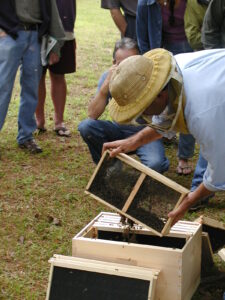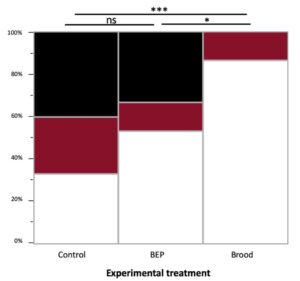Installing a New Package of Bees? Here’s a New Tip to Improve Acceptance
go.ncsu.edu/readext?787168
en Español / em Português
El inglés es el idioma de control de esta página. En la medida en que haya algún conflicto entre la traducción al inglés y la traducción, el inglés prevalece.
Al hacer clic en el enlace de traducción se activa un servicio de traducción gratuito para convertir la página al español. Al igual que con cualquier traducción por Internet, la conversión no es sensible al contexto y puede que no traduzca el texto en su significado original. NC State Extension no garantiza la exactitud del texto traducido. Por favor, tenga en cuenta que algunas aplicaciones y/o servicios pueden no funcionar como se espera cuando se traducen.
Português
Inglês é o idioma de controle desta página. Na medida que haja algum conflito entre o texto original em Inglês e a tradução, o Inglês prevalece.
Ao clicar no link de tradução, um serviço gratuito de tradução será ativado para converter a página para o Português. Como em qualquer tradução pela internet, a conversão não é sensivel ao contexto e pode não ocorrer a tradução para o significado orginal. O serviço de Extensão da Carolina do Norte (NC State Extension) não garante a exatidão do texto traduzido. Por favor, observe que algumas funções ou serviços podem não funcionar como esperado após a tradução.
English
English is the controlling language of this page. To the extent there is any conflict between the English text and the translation, English controls.
Clicking on the translation link activates a free translation service to convert the page to Spanish. As with any Internet translation, the conversion is not context-sensitive and may not translate the text to its original meaning. NC State Extension does not guarantee the accuracy of the translated text. Please note that some applications and/or services may not function as expected when translated.
Collapse ▲Springtime for beekeepers is synonymous with starting new colonies, especially since annual losses have been hovering ~40% every year so that beekeepers need to recoup their numbers. There are three main ways to start new colonies of honey bees. The most recommended method is to make or purchase a local nucleus colony (“nuc”) from an authorized vendor, which typically includes five frames of brood, food stores, and a laying queen. These can be pricey (although well worth the cost), but their availability is often quite limited because of the very high demand. A second way is to see if you can capture a swarm from another colony, but while free for the beekeeper this method is unreliable, risky, and out of one’s control.

A beekeeper establishing a new colony of honey bees using a ‘package’ of ~10,000 workers and a caged queen
One of the more popular means of starting a new colony is to do so with a commercially produced “package” of honey bees. A package consists of a cluster of workers (~10,000 bees weighing approximately 3 lbs) and a newly mated queen (bred by a queen producer) housed in a wood and screen box to facilitate transport (more information can be found in our Beekeeping Note on packages). Package distributors sell these units to beekeepers across the U.S. each spring to replenish winter colony losses, and they tend to be cheaper because they do not include frames of brood or food. This is also why new colonies from packages can be harder to get established—because so much effort has to be placed into making new wax comb and bees—and as such colonies started from packages rarely make surplus honey in their first year (unlike those started from nucs).
There’s another problem that is frequently encountered when installing packaged bees: rejection of the caged queen. When packages are established, usually by large-scale beekeepers in the southern tier of the country, they shake the adult workers from one (or several) colonies into the screened box, but the caged queen is introduced from a completely different colony. As such, the workers and the queen are unrelated to each other, and thus it can take some time for the workers to accept her. However, anywhere from 20-50% of newly established colonies from packages can either fail outright or reject their queen, often raising a new one in her place and setting the colony back several weeks during a very stressful time for the colony.

The proportion of colonies in each experimental treatment that did not rear any queens and accepted the package queen (‘Accepted’ = white), those that reared new queens and replaced the package queen before the colony population turned over (‘Rejected’ = red), and those that successfully superseded the package queen after the colony consisted of her offspring (‘Superseded’ = black).
A recent study conducted by North Carolina Master Beekeeper Eric Talley demonstrated that installing a package of bees into a hive with a single frame of eggs and young larvae resulted in a 200% increase in acceptance of the package queen, resulting in an 86.7% total success rate of colony installation and queen survival. This simple adjustment to installing packaged bees could therefore significantly improve a beekeeper’s success and reduce potential troubles later in the year.
So, if you have some colonies that survived the winter but are establishing more colonies using packaged bees, consider taking a single frame of open brood (ensuring that the queen is not on it!), brush off all of the bees back into their original hive, then place it into the empty hive just before you install the package. If you don’t have any overwintered colonies or are just starting your apiary, ask a beekeeper mentor or another member in your local club for a frame of brood (remembering that young larvae need to be kept warm and can only survive outside of the colony for ~20-30 minutes). When we transfer frames of brood, we do so in a nuc box with a jar of hot water to keep it incubated while in transport.
Losing the queen just as the colony is getting established is a frustrating event for the beekeeper and highly disruptive for the colony. Anything to minimize that possibility would be welcomed, so this new tip might significantly help improve establishment success.


